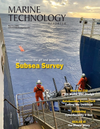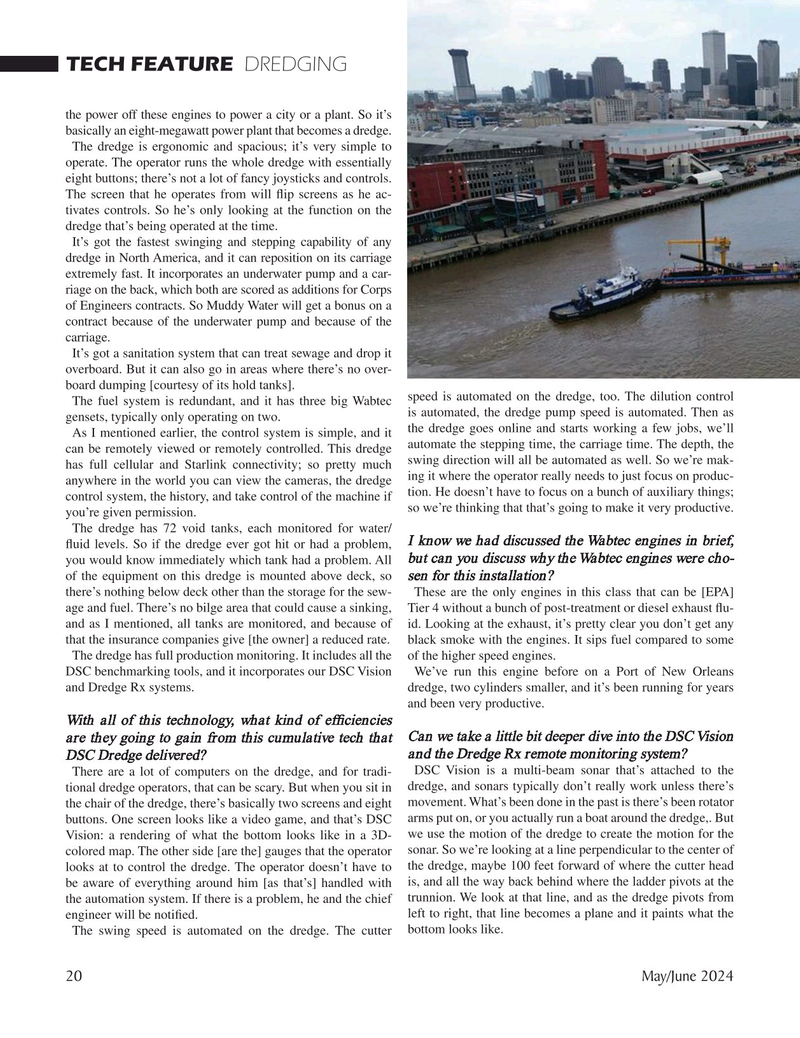
Page 20: of Marine Technology Magazine (May 2024)
Read this page in Pdf, Flash or Html5 edition of May 2024 Marine Technology Magazine
TECH FEATURE DREDGING the power off these engines to power a city or a plant. So it’s basically an eight-megawatt power plant that becomes a dredge.
The dredge is ergonomic and spacious; it’s very simple to operate. The operator runs the whole dredge with essentially eight buttons; there’s not a lot of fancy joysticks and controls.
The screen that he operates from will ? ip screens as he ac- tivates controls. So he’s only looking at the function on the dredge that’s being operated at the time.
It’s got the fastest swinging and stepping capability of any dredge in North America, and it can reposition on its carriage extremely fast. It incorporates an underwater pump and a car- riage on the back, which both are scored as additions for Corps of Engineers contracts. So Muddy Water will get a bonus on a contract because of the underwater pump and because of the carriage.
It’s got a sanitation system that can treat sewage and drop it overboard. But it can also go in areas where there’s no over- board dumping [courtesy of its hold tanks].
The fuel system is redundant, and it has three big Wabtec speed is automated on the dredge, too. The dilution control is automated, the dredge pump speed is automated. Then as gensets, typically only operating on two.
As I mentioned earlier, the control system is simple, and it the dredge goes online and starts working a few jobs, we’ll can be remotely viewed or remotely controlled. This dredge automate the stepping time, the carriage time. The depth, the has full cellular and Starlink connectivity; so pretty much swing direction will all be automated as well. So we’re mak- anywhere in the world you can view the cameras, the dredge ing it where the operator really needs to just focus on produc- tion. He doesn’t have to focus on a bunch of auxiliary things; control system, the history, and take control of the machine if so we’re thinking that that’s going to make it very productive.
you’re given permission.
The dredge has 72 void tanks, each monitored for water/
I know we had discussed the Wabtec engines in brief, ? uid levels. So if the dredge ever got hit or had a problem, but can you discuss why the Wabtec engines were cho- you would know immediately which tank had a problem. All of the equipment on this dredge is mounted above deck, so sen for this installation?
there’s nothing below deck other than the storage for the sew- These are the only engines in this class that can be [EPA] age and fuel. There’s no bilge area that could cause a sinking, Tier 4 without a bunch of post-treatment or diesel exhaust ? u- and as I mentioned, all tanks are monitored, and because of id. Looking at the exhaust, it’s pretty clear you don’t get any that the insurance companies give [the owner] a reduced rate. black smoke with the engines. It sips fuel compared to some
The dredge has full production monitoring. It includes all the of the higher speed engines.
DSC benchmarking tools, and it incorporates our DSC Vision We’ve run this engine before on a Port of New Orleans and Dredge Rx systems. dredge, two cylinders smaller, and it’s been running for years and been very productive.
With all of this technology, what kind of ef? ciencies are they going to gain from this cumulative tech that Can we take a little bit deeper dive into the DSC Vision
DSC Dredge delivered? and the Dredge Rx remote monitoring system?
DSC Vision is a multi-beam sonar that’s attached to the
There are a lot of computers on the dredge, and for tradi- tional dredge operators, that can be scary. But when you sit in dredge, and sonars typically don’t really work unless there’s the chair of the dredge, there’s basically two screens and eight movement. What’s been done in the past is there’s been rotator buttons. One screen looks like a video game, and that’s DSC arms put on, or you actually run a boat around the dredge,. But we use the motion of the dredge to create the motion for the
Vision: a rendering of what the bottom looks like in a 3D- colored map. The other side [are the] gauges that the operator sonar. So we’re looking at a line perpendicular to the center of looks at to control the dredge. The operator doesn’t have to the dredge, maybe 100 feet forward of where the cutter head be aware of everything around him [as that’s] handled with is, and all the way back behind where the ladder pivots at the the automation system. If there is a problem, he and the chief trunnion. We look at that line, and as the dredge pivots from left to right, that line becomes a plane and it paints what the engineer will be noti? ed.
The swing speed is automated on the dredge. The cutter bottom looks like.
20 May/June 2024
MTR #4 (18-33).indd 20 5/29/2024 9:44:16 PM

 19
19

 21
21
